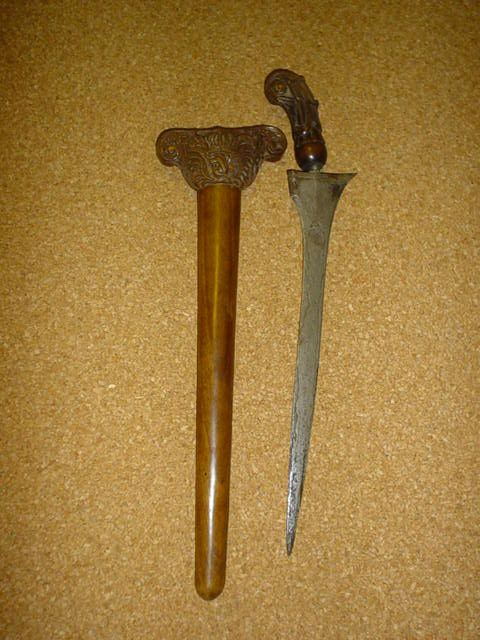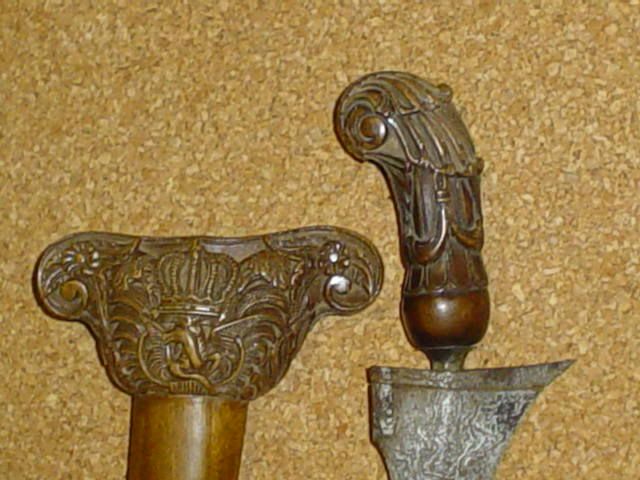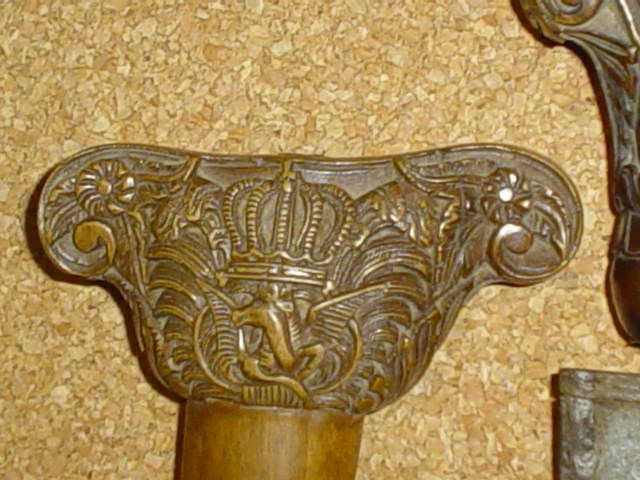
 |
|
|
#1 |
|
Member
Join Date: Dec 2004
Location: USA, Claifornia
Posts: 4
|
 We have had it from the 1952, Someone found it in a pepper case in the early 1900's. It's hilt is VEGETAL & WINGED HORSE There is a dragon going up the blade, and birds ingraved on the sheath. It looks like Kasunanan Pakubuwono had it made for someone? So it could be from the central Java, Madura hosted Dutch garrisons? not sure? But I am looking for all and any info I can find or get. So coments or info would be very helpful      
|
|
|

|
|
|
#2 |
|
Member
Join Date: Dec 2004
Posts: 125
|
Interesting keris mrgee. First off, given the style and quality of the workmanship I feel its very unlikely that this came from the Surakarta kraton. The quality is more on the rough side and given the provenance its likely this is a late 19th or early 20th century example of a "tourist" keris. By tourist, I mean made for sale to Western collectors and visitors. The "date" on the sheath is likely an attempt to trick the unsuspecting visitor. The fact is though that a keris made in 1759 in Yogyakarta would have almost certainly have been inscribed in kawi script, and with a traditional date rather than a Gregorian one.
The blade on this keris appears to have been an older blade that was re-worked. That is, the blade was not originally a naga blade, but has had the naga carved into it subsequently. Notice that the body and head of the naga are "flat" and do not stick out from the overall shape of the blade. The hilt is in a Madura style and looks to have been made from some sort of horn or bone. I doubt very much that it is ivory. The rest of the keris appears more in the style of Yogyakarta. The sheath is unusual and it appears that it may have originally been a ladrangan form that has been re-worked - probably to disguise a break. The oversheath or pendok is also in the Yogya form. |
|
|

|
|
|
#3 |
|
Member
Join Date: Dec 2004
Location: Cincinnati, OH
Posts: 940
|
I agree with Dave on many fronts here. The blade looks reworked, and quickly at that, without a lot of concern for detail. And note the inward lean in the gandik that implies the removal of original material. The sheath looks like it is probably a Maduran Ladrang wrongko with the tail end broken off. Actually, from the photos, i can't see any evidence that this was reworked to hide the fact. And Dave's right about the date on the pendok, it doesn't necessarily refer to the date of the blade, and in this case i'd say there is no way the blade is that old. It looks more late 19th to me.
I'm not sure i agree on the hilt though. I openly admit to being no ivory expert and i have been wrong before, but i don't think this is horn or bone. It displays the patina color and internal grain structure that i have seen in other ivory pieces. Regardless, it is a nice carving with a beautiful patina that seems to imply some real age. I would venture that your hilt, in this case, is more valuable then your blade. |
|
|

|
|
|
#4 |
|
Member
Join Date: Dec 2004
Location: USA, Claifornia
Posts: 4
|
Thanks good info.
But the Deyoung museum here in San Francisco, California USA did some looking at it and said that the glue in the sheath was from 1700's And they also pointed out that the blade was also from the same time, But they wanted more info on the seal? I showed it to embasy here in the states, and they are the ones that gave me the Sultans name and the area it mit of come from. Some one else said it was from the 1958, but we got it in 1952 and the person before us got it in the early 1900's. Found it in a shipping create of pepper? Hidden? If someone reworked to disguise a break in the sheath they did one of the best jobs I have ever seen. It is very heard to find the seams, I can only see the ones at the bottom. As for the hilt, the Deyoung musem said it was ivory, maybe found in the mash area. That is why the coloring is the way it is. They have been after this Keris for years, for us to donate it to them. because it in better condition then the ones they have and it is older. Oh well thats what I have been told. But the seal does to me seem european, and I always have wander about it. |
|
|

|
|
|
#5 |
|
Member
Join Date: Dec 2004
Location: Cincinnati, OH
Posts: 940
|
Well MrGee, with all due respect to the Deyoung Museum, i am afraid they don't know what they are talking about. Being a museum does not make you knowledgable on ALL matters. I did visit their web site and check out their keris (kris) collection. http://search.famsf.org:8080/search.shtml?keywords=kris
They appear to have only three examples and none are complete (i.e. none have sheaths and the two Bali keris have no hilt rings [mendak]). One of the three is actually a Moro kris, and they seem to make no distinction to the differences here, nor do they ID the others as Bali keris. They don't appear to know there is an importance to the actual origins here. To them i guess all keris are the same. The glue on you sheath may very well be from the 1700s, but i can assure you, the sheath itself is not.  The museum might be interested in you keris because it does appear to have a rather nice ivory handle, but the blade you have is inferior to any of the three they have in their collection. If by some chance this is not an altered blade, it is not a very good keris naga original. Though i would bet the naga was carved at a latter date to increase the sellablity of the keris. It would probably be helpful for you to look at a lot of other keris to fully understand what we are talking about. The museum might be interested in you keris because it does appear to have a rather nice ivory handle, but the blade you have is inferior to any of the three they have in their collection. If by some chance this is not an altered blade, it is not a very good keris naga original. Though i would bet the naga was carved at a latter date to increase the sellablity of the keris. It would probably be helpful for you to look at a lot of other keris to fully understand what we are talking about. As for your sheath, again, you need to see other examples. There used to be a tail section that swooped up on the back end or your sheath. Try doing a google search and look at other examples and you will see what i mean. There is still a bit of wood that juts out where this piece would have begun. It may have broken off long ago and been sanded and refinished, but this is not the original condition of your sheath. As for the seal, the European look is not unusual. You must remember that the Dutch were in this area for centuries and certainly left some influence. The "K" probably represents Kasunanan, which is the royal kraton (palace) of the Surakarta kingdom built in the mid 1700 by Pakubuwono II. But this seal would more likely be a commemorative, like the minting of the first Washington quarter in 1932 to celebrate 200 yrs. since the birth of George Washington. This sheath was not made in 1753. Sorry. |
|
|

|
|
|
#6 |
|
Member
Join Date: Dec 2004
Location: Cincinnati, OH
Posts: 940
|
A very learned friend of has made an interesting suggestion about the numbers on the pendok of your sheath which i had not considered:
"Javanese are into numerology in a big way; the way this number is written suggests to me that it might be intended to be a magic square:- top-13, right 58,bottom 6, left 77:- this would come down to 4, 4, 6, 5, which could be read as is, or as 1, the number one coming from sum of 4+4+6+5= 19= 9+1= 1. The number one in Javanese numerology can have a number of interpretations, but it is a powerful number.Alternatively, the numbers could be read as individual combinations to produce a four digit number which could be read to produce a meaning." Numbers written on keris sheaths that have personal numerological sugnificance is not at all an unusal thing, so it is very possible that this is not a date at all. BTW, how well does the keris fit into the sheath? Could you provide a photo that is shot down on the keris in the sheath so we can see the fit. If the shape of the opening is not perfect to the shape of the gonjo, this sheath probably wasn't made for this keris. The hilt is Maduran, the sheath is Javanese and the blade is a lower quality than the dress; these are all signs that this is a composit piece put together for foriegn sale to an uninformed buyer. Could we also see a better photo of the "broken" part of the sheath as well? BTW, my friend concurs that the hilt is ivory, probably marine ivory. The color and the markings are right. |
|
|

|
|
|
#7 |
|
Member
Join Date: Dec 2004
Location: The Netherlands
Posts: 1,209
|
MrGee,
Nechesh is right. The blade is not original for this dress. It might be an older blade on wich the naga was later worked out. The naga is not original and not worked out like a naga should be. The ukiran is ivory and a very nice one and as said here more worth than the entire piece. The scabbard is not from 1753. It is from around 1900. If it came hidden in a pepper box around 1952 from Indonesia it is impossible that that scabbard was 200 years old. Wooden parts had to be replaced frequently because of the humid climate. The wrangka was originally a ladrang but as Nechesh said the flags are broken. I think your ladrang is a javanese one. I own a similair piece. This keris is original madura. I became the keris from a colleague. After the dead of his mother last year he had to empty the house and found this keris on the attic. It was brought home by his father who was a mariner and had served there during the war. The keris hung on the wall in the living room but when his father died it was brought to the attic. He showed me the keris and the wrangka had the same damage like yours the flags were broken. I immediately recognized it as a maduran keris. He asked me what to do with this rubbish and I told him I collect this kind rubbish.  He wished me luck with it. With sandpaper I polished the wrangka in the same shape like yours. He wished me luck with it. With sandpaper I polished the wrangka in the same shape like yours.Your pendok has a crowned weapon that probably is from the dutch influence. As Dave said as it is really old the numbers weren't written in gregorian. Madura was the part of Indonesia that was most loyal to the dutch and they used dutch crowns and dutch military emblems on their ukirans. So for a maduran pendok a crowned shield is not unlikely. For a javanese one it is rather uncommon. The picture of the wrangka is too dark. If it is maduran it should have at the bottom of the longest side of the wrangka a small curving in a flowerlike motiv. But your wrangka is rather long and a maduran is shorter an more rounder. This was an original madura wrangka ladrang. The ukiran is bone.    This is an original madura ladrang. 
Last edited by Henk; 1st January 2005 at 12:28 PM. |
|
|

|
|
|
#8 |
|
Member
Join Date: Dec 2004
Location: USA, Claifornia
Posts: 4
|
Lots of good info.
I was wondering about the numbers and I saw the one number as 77 but didn't understand why, but numerology hmmm maybe. I will go to dads house and take some more pics, and turn on my macros to get closer to the keris. This is the info on the hilt that I have found---- Madura hilts are among the most beautiful. The overall shape is similar to central Java, however these hilts are intricately carved with reminiscent of Dutch influence and remains of Hindu influence. Madura hosted Dutch garrisons, and many Madurese enrolled the Dutch army. Therefore, local hilts, called Landhian, were decorated with helmets, shoulder pads and other western military attributes. The winged horse Kuda Panole is one of the common carvings seen on hilts from Madura, it is part of the Sumenep coat of arms. The legend of Kuda Panole goes back to the last Majapahit king, Brawijaya and his son-in-law Jaka Tule, Prince of Sumenep. While Jaka Tule was leaving Brawijaya, a horse escaped and nobody could control the animal. When Jaka Tule approached the horse, it was subdued, it kneeled down before the Prince and turned its sight backwards. Thanks a lot Mrgee |
|
|

|
|
|
#9 |
|
Member
Join Date: Dec 2004
Location: The Netherlands
Posts: 1,209
|
MrGee,
Maduran ukirans are very beautiful indeed. But in the other parts of Indonesia they knew and know how to make some beautiful ukirans too This is such an ukiran with dutch army influences. Just a simple wooden one. |
|
|

|
|
|
#10 |
|
Member
Join Date: Dec 2004
Location: Sint-Amandsberg (near Ghent, Belgium)
Posts: 830
|
Here's another Maduran keris with a different type of scabbard. Is this type called 'sandang walikat' ?
The winged horse is also clearly seen.   
|
|
|

|
|
|
#11 |
|
Member
Join Date: Dec 2004
Location: USA, Claifornia
Posts: 4
|
I also have to ask about the birds on the sheath, I haven't seen that before.
In the 2nd pic you can see the fit into the sheath, it's almost perfict. but I will take bettwer pic's of it. After I was looking at the blade I can see the naga was added but it still looks to me as if it was done at the time of making the blade? In looking more at the sheath and on the site of http://perso.wanadoo.fr it looks like it could be a WARANGKA LADRANG, MADURA (IRAS) I know the one pice is broken off and maybe the other site I dont remember. But I will look next time and take a pic. Well more pics to come later. |
|
|

|
 |
| Thread Tools | Search this Thread |
| Display Modes | |
|
|